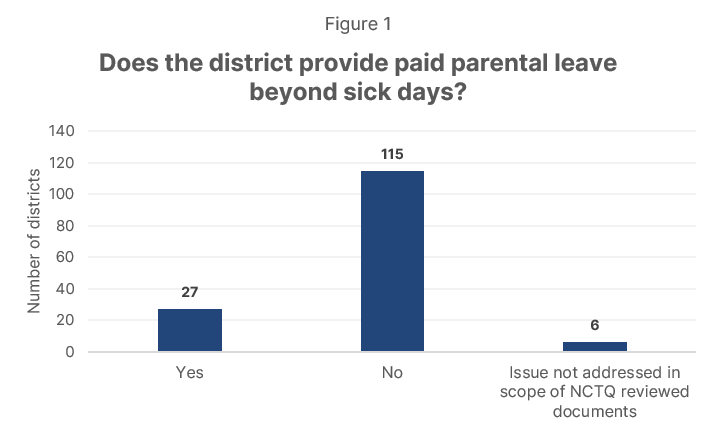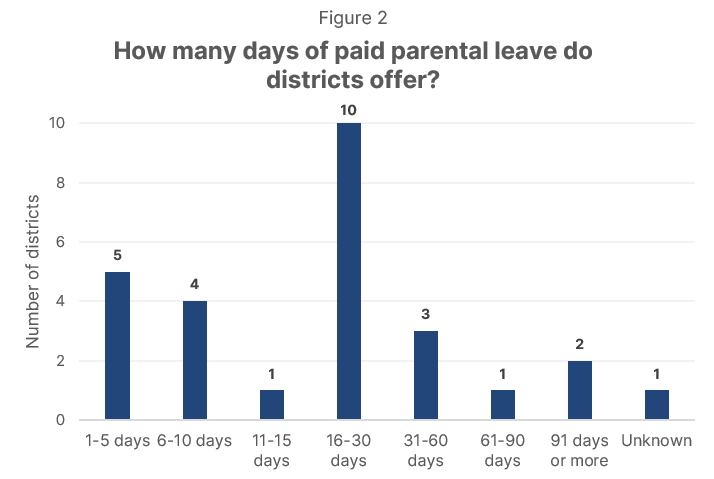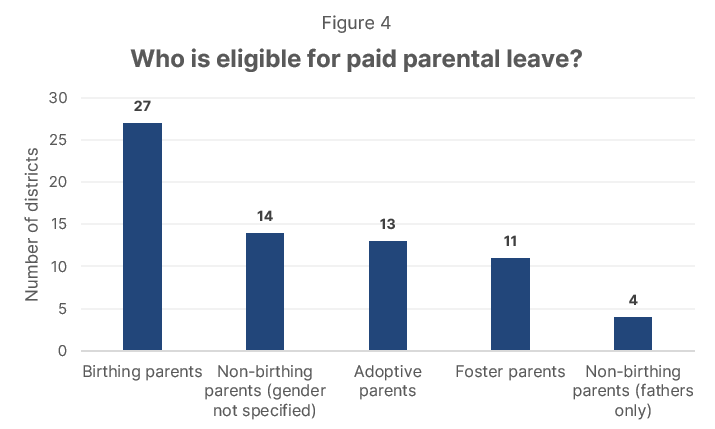Teachers in Columbus, Ohio made history earlier this year when a highly-publicized strike resulted in a new paid parental leave policy, offering teachers 20 days of paid leave in addition to earned sick leave.1 A few years earlier, teachers in New York City made headlines after a petition to provide paid parental leave garnered 85,000 teacher signatures, and resulted in New York City Schools and the United Federation of Teachers (UFT) jointly rolling out six weeks of paid leave.2,3 These new benefits align with medical consensus on the importance of paid family leave and come during a growing movement to provide leave to families nationwide.
As the national conversation on paid parental and family leave has gained traction, have other school districts taken note? In this
District Trendline, we find that while most large districts still do not offer this benefit, a few have taken some important steps to offer some parental leave.4
Below, we review districts’ parental leave policies, summarize the research on how family leave policies may benefit teacher-parents and their children, and consider how offering paid leave can help districts support and retain teachers.
How many districts offer paid parental leave, and how much do they offer?
Paid parental leave has well-documented and wide-ranging benefits for the health and well-being of babies, birthing parents, and non-birthing parents.5 Yet few school districts offer any paid parental leave for teachers6 beyond earned sick days. Less than a quarter of districts in our sample (18%) provide this benefit; of those that do, the amount of leave offered varies widely, ranging from one day to five months, with most districts offering less than 31 days (all at varying levels of pay and with differing eligibility). The International Labor Organization recommends a minimum of 18 weeks for birthing parents, since called a “reasonable goal” for the American workforce by the Office of the U.S. Surgeon General, though few employers in the United States offer this amount of leave.

This analysis considers paid family leave policies that extend beyond normal sick leave.7 Most teachers receive an average of between 10 and 14 days of sick leave each year.8 If teachers were to rely solely on sick leave, they might have as little as two weeks at home after giving birth, assuming they had not taken any sick time before the baby’s arrival (and in doing so, would deplete all available sick days for the rest of the year).
Many districts’ parental leave policies require teachers to exhaust all accumulated sick leave (and/or ‘personal business’ leave) before they can receive access to paid leave. A few districts go further by requiring teachers take additional days without pay after using all available sick leave in order to be eligible for paid leave (as one of several examples,
Northside Independent School District (TX) requires teachers to take five unpaid days).
Many districts rely on use of the Family and Medical Leave Act (FMLA)—a federal policy that provides 12 weeks of job-protected leave for both personal health and family caregiving events, including giving birth or welcoming a child—as teachers’ primary way of accessing parental leave. Yet this leave is unpaid, a barrier that may make taking leave through FMLA difficult or impossible. It is also not an option for all teachers, as employees are not eligible for FMLA until they have worked for their employer for 12 months.
Of the districts in our sample,
Elk Grove Unified School District (CA) provides the longest term of leave, specifying that after the teacher has exhausted all sick leave, the district provides a five month partially-paid “extended illness leave” which may be used for pregnancy, miscarriage, childbirth, and recovery therefrom. Wichita Public Schools (KS) also offers a generous amount of accrued leave for birthing parents, with a maximum of 180 days.9

| Note: This includes all days of leave offered, regardless of who is eligible to take them. |
How much pay do districts offer during parental leave?
Of the districts in our sample that provide access to paid parental leave (18%), 11 offer all days of the leave at full pay.10 Another 15 provide compensation below the full amount of a teacher’s regular paycheck, meaning that teachers would have an extended pay cut should they want or need to access parental leave. Seven of these 15 districts make this calculation by subtracting the cost of the substitute’s pay from teachers’ paychecks during time on leave,11 and one district does not specify pay.

Who is eligible for paid parental leave?
Teachers are most often eligible for parental leave after giving birth to a child: 27 districts, or 18% of the sample, offer paid parental leave to a birthing parent. Eighteen districts in our sample offer some amount of leave to fathers and/or non-birthing parents when the teacher’s co-parent gives birth.12,13 Jordan School District (UT), for instance, provides six weeks of leave for mothers, and two weeks for non-maternal parents. Four of the 18 districts specify leave for non-birthing parents as specifically “paternity leave,” making it unclear what benefits non-birthing parents who are not fathers can expect, if any.
Thirteen districts provide some leave for adoption, and 10 of these districts provide leave equivalent to maternity leave.14 Eleven districts provide leave to welcome a foster child, also typically equivalent to maternity leave.15,16 Two districts, Elk Grove Unified School District (CA) and Wichita Public Schools (KS), provide paid leave for recovery when a pregnancy ends before birth.

Some districts explicitly limit what parental leave can be used for, such as
Frisco Independent School District (TX), which specifies that the 10 days of partially paid leave may not be used “for routine well-baby care or bonding time,” but rather only for pregnancy related injury and illness.
Of note, some districts in our sample are located in the
11 states and the District of Columbia that either currently offer or have recently passed policies that will extend paid parental leave statewide.17
How are districts using gender-neutral and inclusive policies?
Districts can draft policies that include all families by using gender neutral language and offering leave that reflects the many possible ways families welcome new children.
Seattle Public Schools‘ (WA) contract provides the following: “Up to five (5) days total shall be granted with pay upon application to Human Resources to parents or guardians for the purpose of care for a newborn child or for the placement of a child with the employee for foster care or guardianship or other emergency situations where the employee has recently become legally responsible for the care of a newborn or minor child.”
Other districts use gender neutral language and more inclusive phrasing that can account for a range of ways that a teacher might start a family.
Fort Wayne Community Schools (IN) refers to the three days of parental leave it provides for non-birthing parents as “for the birth of a teacher’s child other than by pregnancy of the teacher”—language that could be interpreted to cover parental leave for a partner regardless of gender identity, and to provide leave for surrogacy.
Drafting inclusive policies also means considering how and whether or not teachers might receive differential benefits based on how they start a family. To be sure, birthing parents may need additional time to recover from giving birth. But providing no leave, or less generous leave, to welcome a newborn through adoption, surrogacy, or foster parenting may disproportionately impact certain groups of teachers based on their identity—LBGTQ+ and non-cisgender parents, for example.
Paid parental leave: A win for teacher well-being and retention?
On top of the well-documented benefits to new parents and their children (some of whom may be future students of the district),18 districts may find that offering a competitive family leave policy could pay dividends in better teacher well-being and retention.
Benefits of paid leave
Access to parental leave presents tangible benefits to teachers and their newborns. Global research has found a strong link between parental leave and decreased infant mortality, along with other key infant health metrics.19 Lack of paid leave is associated with lower parental and infant health and well-being, with effects on child development that can be seen years later.20 When new mothers gain access to paid leave, their health outcomes are remarkably improved: lowered blood pressure, lowered pain, and up to 51% lower likelihood of being rehospitalized after giving birth.21
Access to paid parental leave for fathers is also important for the long term well-being of both parents and children. Years later, the children of fathers who took at least two weeks of paternity leave reported feeling closer to their dads and having better communication with them.22 One recent study found that fathers taking paid leave was associated with better long-term relationship success between parents, including significantly lower rates of divorce.23 Another large-scale study of Swedish paid leave reforms found that new fathers taking paternity leave reduced postpartum mothers’ likelihood of being prescribed anxiety medication by 26%, and lowered maternal risk of physical health complications postpartum.24 Still another found that introducing access to paternity leave was associated with lowered stress and depression for mothers and lessened fatigue for new fathers.25 Taken together, this evidence points to the importance of providing both parents with leave.
Supporting new parents’ mental health
Districts nationwide have struggled to respond to a documented teacher mental health crisis. Teachers report higher symptoms of stress and depression than other working adults—a phenomenon that was exacerbated by the pandemic.26 Teachers’ mental health challenges, already troubling enough on their own, also have discernable impact on student learning and well-being.27 While research is scant on the health impacts of parental leave for teachers specifically, there is ample evidence that without access to paid parental leave, new parents (particularly mothers and birthing parents) experience increased mental health symptoms.28 Districts may find that offering paid leave as part of a wider teacher well-being strategy may help new parents experience fewer struggles when they return to the classroom.
Reducing attrition
Lack of access to paid parental leave may also have a relationship with teacher attrition. Studies have found that lack of access to paid leave causes women to leave the workforce at a higher rate; and when women gain access to paid leave, they are more likely to return to the workforce.29 A 2012 study identified a pattern of female teachers leaving the profession while their children were young, then re-entering the profession as their children reach school age.30 In their sample, the authors found that compared to other teachers who leave and later return to the classroom, those who exited and did not return in a given year were far more likely to have newborn children. New research revisited this pattern to determine if it persisted in more recent cohorts of teachers exiting the classroom, and found that this pattern had disappeared in more recent cohorts: teachers with young children still leave at similar rates, but do not appear to re-enter after their children have grown older.31 Given how few teachers receive paid parental leave, it remains to be seen whether or not broader access to leave (ideally coupled with childcare subsidies)32 might bring more teachers back to the classroom, but it is a hypothesis worth testing.
The most recent federal data available
shows that a quarter of teachers who recently left teaching reported “personal life reasons (e.g., health, pregnancy/childcare, caring for family)” as the most important reason that factored into their decision to quit, while 61% ranked personal life reasons between “very important” and the “most important” reason for leaving.33 Sixty-one percent of leavers reported that their new jobs provided more ability to balance personal life and work.34 More recent data from the RAND Corporation also found that recent leavers reported that their new jobs provided greater flexibility.35 Data from Educators for Excellence’s 2022 nationally-representative survey of teachers found that 37% of teachers ranked “improved family support (discounted daycare, maternity leave, etc.)” as one of the top three financial incentives to recruit and retain teachers. This number rose to 65% for educators of color, and to 42% for teachers under thirty.
On the other hand, a recent
Education Week survey found that teachers as a whole ranked paid parental leave comparatively low in a list of potential benefits (such as higher pay and increased pension benefits) that would persuade them to stay in teaching over the long term. While paid parental leave may not be all teachers’ top priority, the survey did not separate out respondents by age or intention to have children in the future, meaning that the aggregate results could obscure a real interest from a subset of teachers.36,37
Getting started
When considering adding or expanding access to paid leave, districts will likely have questions about cost and staffing logistics. These policies present districts with two main costs: the cost of paying the salary of teachers on leave, and the cost of staffing teachers’ classrooms while they are out. To understand the cost of paying teachers while on leave, districts can use historical data on how many teachers typically use unpaid or sick leave for the birth of a child as a baseline to estimate increased salary costs.
The second cost is staffing teachers’ classrooms while they’re on leave. Here again, it would be helpful to look at available FMLA data: if many teachers take less than the available leave (e.g., six weeks instead of 12), it is possible that teachers would take more time if it were paid, and so the school would need to pay a substitute teacher for more time. However, if teachers already take the maximum available time and a parental leave policy would offer added financial support but not additional time off, the district may not see big changes in staffing needs. Creative staffing models like job sharing or team teaching models could also help alleviate some of these costs.
Districts should also consider how paid parental leave might fit into their longer term strategy to reduce teacher attrition. In light of current substitute shortages and concerns about staffing, districts might be reluctant in the immediate term to provide a benefit that increases teachers’ time on leave. Taking a longer view, districts would do well to consider whether they face a higher long term cost if teachers exit the district due to lack of available parental leave. Estimates place the cost of attrition starting at about $9,000 per teacher,38 to say nothing of the impact on students; if offering paid family leave reduces attrition, the upfront cost of providing this benefit might prevent larger costs to students and future costs to the district budget.
As the national conversation around paid parental leave gains momentum, districts should consider how offering this benefit contributes to their goals for attracting, supporting, and retaining a diverse and effective teacher workforce.
More like this

Teachers want families, too: Why it’s time for paid family leave

How are districts observing and providing feedback to teachers?

What teachers really want: It isn’t just higher salaries

Building a school climate that makes teachers want to stay

Leave and health insurance for teachers: safeguards amid COVID-19 worries
Endnotes
- Columbus Public Schools’ new plan totals thirty days of leave for birthing parents: ten days of leave unpaid or using accrued leave, plus twenty days of paid leave at 70% of a teacher’s salary, with the option to receive 100% of salary if the teacher supplements with use of accrued leave. Of note, Columbus does not have a fully reconciled final version of their updated contract, and so their contract included in the Teacher Contract Database and analyzed in this piece does not reflect their recent adoption of a parental leave policy.
- Leave to give birth or welcome a biological, adoptive, or foster child is often referred to interchangeably as “paid parental leave” or “paid family leave.” We use these terms interchangeably, but specify that “paid family leave” does not refer to forms of family leave that include leave for reasons like family illness.
- When compared to the agreements highlighted below, this leave agreement is unusual: New York City Public Schools agreed to six weeks unpaid leave for a new parent, during which the district discontinues salary and pension payments, while the state continues to provide healthcare. In addition, the new parent receives a lump sum from their union, the UFT, equivalent to their regular compensation for that time period. Because the district itself technically does not offer this time as paid, we do not consider New York City Public Schools as part of the total number of districts who provide paid family leave.
- The NCTQ sample of districts includes 148 school districts in the United States: the 100 largest districts in the country, the largest district in each state, and the member districts of the Council of Great City Schools.
- We use gender neutral language to refer to birthing and non-birthing parents throughout, unless the research or policy to which we refer is specifically gendered (e.g., maternal or paternal).
- NCTQ’s Teacher Contract Database does not collect data about policies related to staff other than teachers, and so we cannot determine the extent to which other school staff, such as paraprofessionals, have access to paid parental leave through their contracts.
- The Teacher Contract Database (TCD) includes district collective bargaining agreements (CBAs), memorandums of understanding (MOUs), and Board policies.
- According to previous TCD analysis, 69% of districts in our sample allow teachers to roll over sick days and do not limit accumulation. See: Saenz-Armstrong, P. (2020, October 20). Leave and health insurance for teachers: Safeguards amid COVID-19 worries. National Council on Teacher Quality (NCTQ).
- This policy is far more limited for non-birthing new parents: only three temporary leave days can be used for paternity leave, while 14 can be used for adoption.
- These include: Brevard Public Schools (FL), El Paso Independent School District (TX), Fort Wayne Community Schools (IN), Jordan School District (UT), Montgomery County Public Schools (MD), Prince George’s County Public Schools (MD), Rochester City School District (NY), Round Rock Independent School District (TX), San Diego Unified School District (CA), Seattle Public Schools (WA) and Wichita Public Schools (KS).
- These seven include six districts who dock the rate of substitute pay from a teacher’s salary for the full time of their leave, and one that deducts substitute pay for only part of their period of leave.
- This trend is largely driven by California districts following state law: California Education Code Section 44977.5, which requires that teachers, regardless of whether they gave birth, be given 12 weeks of leave at half pay to welcome a child. When California districts are excluded from this count, only nine districts in our sample provide some paternity leave.
- These eighteen districts include: Fort Wayne Community Schools (IN), Brevard Public Schools (FL), Capistrano Unified School District (CA), Chicago Public Schools (IL), Conroe Independent School District (TX), Corona-Norco Unified School District (CA), El Paso Independent School District (TX), Garland Independent School District (TX), Long Beach Unified School District (CA), Los Angeles Unified School District (CA), Oakland Unified School District (CA), Rochester City School District (NY), Seattle Public Schools (WA), Stockton Unified School District (CA) Jordan School District (UT), Round Rock Independent School District (TX), San Diego Unified School District (CA), and Wichita Public Schools (KS).
- The 13 districts who provide some leave for adoption are: Brevard Public Schools (FL), El Paso Independent School District (TX), Garland Independent School District (TX), Lewisville Independent School District (TX), Long Beach Unified School District (CA), Los Angeles Unified School District (CA), Oakland Unified School District (CA), Rochester City School District (NY), Round Rock Independent School District (TX), San Diego Unified School District (CA), Seattle Public Schools (WA), Stockton Unified School District (CA), and Wichita Public Schools (KS).
- The 11 districts who provide some leave for fostering are: Conroe Independent School District (TX), El Paso Independent School District (TX), Garland Independent School, District (TX), Lewisville Independent School District (TX), Long Beach Unified School District (CA), Los Angeles Unified School District (CA), Oakland Unified School District (CA), Rochester City School District (NY), Round Rock Independent School District (TX), Seattle Public Schools (WA), and Fort Wayne Community Schools (IN).
- The total percentage of Teacher Contract Database districts offering parental leave for adoption and foster care is driven in part by California districts following California Education Code Section 44977.5, which covers both foster and adoptive leave. When California districts are excluded, only eight districts provide some paid parental leave for adoption or fostering.
- Unless the district’s contract language or Board policy specifically mentions adherence to the state’s law, this may not be reflected in the Teacher Contract Database.
- The benefits to future students may not be insignificant: The developmental benefits of paid leave to children appear to extend past infanthood and into schooling years: several studies have found developmental impacts that can be seen at least as far as Pre-K. See: Berger, L. M., Hill, J., & Waldfogel, J. (2005). Maternity leave, early maternal employment and child health and development in the US. The Economic Journal, 115(501), F29-F47; Gaston, A., Edwards, S. A., & Tober, J. A. (2015). Parental leave and child care arrangements during the first 12 months of life are associated with children’s development five years later. International Journal of Child, Youth and Family Studies, 6(2), 230-251. Further, when Norway instituted a universal family paid leave program in 1977, it increased high school graduation rates for children who had benefited from the program by 2 percentage points, increased college-going by 3.5 percentage points, and increased earnings by age 30 by 5-7 percentage points, with the highest gains seen by children whose mothers had the lowest education and least access to paid leave prior. See: Carneiro, P., Løken, K. V., & Salvanes, K. G. (2015). A flying start? Maternity leave benefits and long-run outcomes of children. Journal of Political Economy, 123(2), 365-412.
- Bullinger, L. R. (2019). The effect of paid family leave on infant and parental health in the United States. Journal of Health Economics, 66, 101-116; Nandi, A., Hajizadeh, M., Harper, S., Koski, A., Strumpf, E. C., & Heymann, J. (2016). Increased duration of paid maternity leave lowers infant mortality in low-and middle-income countries: a quasi-experimental study. PLoS Medicine, 13(3), e1001985; Ruhm, C. J. (2000). Parental leave and child health. Journal of Health Economics, 19(6), 931-960.
- Gaston et al. (2015); Berger et al. (2005).
- Bütikofer, A., Riise, J., & Skira, M. M. (2021). The impact of paid maternity leave on maternal health. American Economic Journal: Economic Policy, 13(1), 67-105; Jou, J., Kozhimannil, K. B., Abraham, J. M., Blewett, L. A., & McGovern, P. M. (2018). Paid maternity leave in the United States: associations with maternal and infant health. Maternal and Child Health Journal, 22(2), 216-225.
- Petts, R. J., Knoester, C., & Waldfogel, J. (2020). Fathers’ paternity leave-taking and children’s perceptions of father-child relationships in the United States. Sex Roles, 82(3), 173-188.
- Petts, R. J., Carlson, D. L., & Knoester, C. (2020). If I [take] leave, will you stay? Paternity leave and relationship stability. Journal of Social Policy, 49(4), 829-849.
- Persson, P., & Rossin-Slater, M. (2019). When dad can stay home: fathers’ workplace flexibility and maternal health. National Bureau of Economic Research. (No. w25902).
- Cardenas, S. I., Corbisiero, M. F., Morris, A. R. et al. (2021). Associations between Paid Paternity Leave and Parental Mental Health Across the Transition to Parenthood: Evidence from a Repeated-Measure Study of First-Time Parents in California. Journal of Child and Family Studies, 30, 3080–3094.
- Steiner, E. D., Doan, S., Woo, A., Gittens, A. D., Lawrence, R. A., Berdie, L., Wolfe, R.L., Greer, L., & Schwartz, H. L. (2022). Restoring Teacher and Principal Well-Being Is an Essential Step for Rebuilding Schools: Findings from the State of the American Teacher and State of the American Principal Surveys. Research Report. RR-A1108-4. RAND Corporation.
- McLean, L., Abry, T., Taylor, M., & Connor, C. M. (2018). Associations among teachers’ depressive symptoms and students’ classroom instructional experiences in third grade. Journal of School Psychology, 69, 154-168; Jeon, L., Buettner, C. K., & Snyder, A. R. (2014). Pathways from teacher depression and child-care quality to child behavioral problems. Journal of Consulting and Clinical Psychology, 82(2), 225; McLean, L., & Connor, C. M. (2015). Depressive symptoms in third grade teachers: Relations to classroom quality and student achievement. Child Development, 86(3), 945-954.
- Van Niel, M. S., Bhatia, R., Riano, N. S., de Faria, L., Catapano-Friedman, L., Ravven, S., Weissman, B., Nzodom, C., Alexander, A., Budde, K., & Mangurian, C. (2020). The impact of paid maternity leave on the mental and physical health of mothers and children: a review of the literature and policy implications. Harvard Review of Psychiatry, 28(2), 113-126.
- Jones, K., Wiltcher, B. (2020). Reducing maternal labor market detachment: A role for paid family leave. Washington Center for Equitable Growth.
- Grissom, J. A., Reininger, M. (2012). Who Comes Back? A Longitudinal Analysis of the Reentry Behavior of Exiting Teachers. Education Finance and Policy 7(4): 425–54.
- Moyer, A. (2022). Has “Who Comes Back” Changed? Teacher Reentry 2000–2019. Educational Researcher.
- Authors Grissom and Reininger calculated that 57% of younger women (40 or younger) surveyed as part of NCES’ Teacher Follow Up Study said that the “availability of suitable childcare options” would be very or extremely important in their decision to return to teaching.
- U.S. Department of Education, National Center for Education Statistics, Teacher Follow-up Survey (TFS), “Former Teacher Data File,” 2012-13.
- U.S. Department of Education, National Center for Education Statistics, Teacher Follow-up Survey (TFS), “Former Teacher Data File,” 2012-13.
- Diliberti, M., Schwartz, H. L., & Grant, D. M. (2021). Stress topped the reasons why public school teachers quit, even before COVID-19. RAND Corporation.
- Interestingly, urban teachers in Education Week’s survey were more likely to indicate that maternity/paternity leave factored into their retention than rural and suburban teachers; while elementary and high school educators ranked this benefit more highly than middle school educators. This suggests that paid parental leave may be a benefit that is particularly important to attract and retain certain segments of the teaching population.
- Sawchuk, S. (2022, July 27). Better Pay Would Keep Teachers From Quitting. But There’s More to It. Education Week.
- Barnes, G., Crowe, E., & Schaefer, B. (2007). The cost of teacher turnover in five school districts: A pilot study. National Commission on Teaching and America’s Future.

